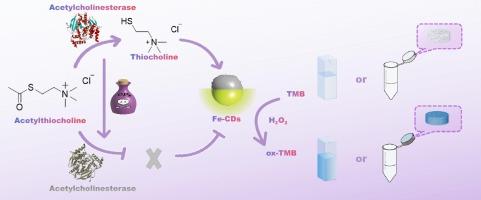Peroxidase-mimetic carbon dot based nanozyme hydrogel colorimetric sensor for visual trichlorfon detection
IF 4.6
2区 化学
Q1 SPECTROSCOPY
Spectrochimica Acta Part A: Molecular and Biomolecular Spectroscopy
Pub Date : 2025-03-11
DOI:10.1016/j.saa.2025.126027
引用次数: 0
Abstract
Organophosphorus pesticide residues pose considerable threats to the environment and public health and have become a global concern. This paper reports the development of a visual sensing platform for the detection of trichlorfon based on a carbon-based nanozyme (abbreviated as Fe-CDs) with peroxidase-mimetic catalytic activity in conjunction with acetylcholinesterase (AChE). The peroxide-mimetic enzyme activity of Fe-CDs can be inhibited by sulfhydryl (–SH) compounds, and AChE can decompose thiocholine (ATCh) to produce –SH-containing thiocholine (TCh), leading to the inability of Fe-CDs to oxidise 3,3′,5,5′-tetramethylbenzidine (TMB) to turn the solution blue, while trichlorfon can inhibit the activity of AChE, thereby recovering the blue colour. This platform achieves sensitive detection of trichlorfon with a linear range of 200–50,000 pM and a detection limit of 157.57 pM and has been successfully applied to the detection of trichlorfon in Chinese cabbage. In addition, encapsulating Fe-CDs, ATCh and TMB in sodium alginate hydrogels and using a smartphone and colour analysis software, a colorimetric hydrogel portable kit is developed, realising the simple and rapid detection of the trichlorfon residue in real samples. This study provides a direct, simple and rapid strategy for the detection of trichlorfon in agricultural products and offers a potential on-site detection tool for food safety monitoring.

模拟过氧化物酶碳点纳米酶水凝胶比色传感器用于视觉检测敌百虫
有机磷农药残留对环境和公众健康构成严重威胁,已成为全球关注的问题。本文报道了基于模拟过氧化物酶催化活性的碳基纳米酶(简称Fe-CDs)和乙酰胆碱酯酶(AChE)的视觉检测平台的开发。Fe-CDs的过氧化物模拟酶活性可被巯基(-SH)化合物抑制,AChE可分解硫代胆碱(ATCh)生成含-SH的硫代胆碱(TCh),导致Fe-CDs无法氧化3,3 ',5,5 ' -四甲基联苯胺(TMB)使溶液变蓝,而敌百虫可抑制AChE活性,使溶液恢复蓝色。该平台实现了对敌百虫的灵敏检测,线性范围为200-50,000 pM,检出限为157.57 pM,已成功应用于大白菜中敌百虫的检测。此外,将Fe-CDs、ATCh和TMB包封在海藻酸钠水凝胶中,利用智能手机和颜色分析软件,开发了一种比色水凝胶便携式检测试剂盒,实现了实际样品中敌百虫残留的简单快速检测。本研究为农产品中敌百虫的直接、简单、快速检测提供了一种策略,为食品安全监测提供了一种潜在的现场检测工具。
本文章由计算机程序翻译,如有差异,请以英文原文为准。
求助全文
约1分钟内获得全文
求助全文
来源期刊
CiteScore
8.40
自引率
11.40%
发文量
1364
审稿时长
40 days
期刊介绍:
Spectrochimica Acta, Part A: Molecular and Biomolecular Spectroscopy (SAA) is an interdisciplinary journal which spans from basic to applied aspects of optical spectroscopy in chemistry, medicine, biology, and materials science.
The journal publishes original scientific papers that feature high-quality spectroscopic data and analysis. From the broad range of optical spectroscopies, the emphasis is on electronic, vibrational or rotational spectra of molecules, rather than on spectroscopy based on magnetic moments.
Criteria for publication in SAA are novelty, uniqueness, and outstanding quality. Routine applications of spectroscopic techniques and computational methods are not appropriate.
Topics of particular interest of Spectrochimica Acta Part A include, but are not limited to:
Spectroscopy and dynamics of bioanalytical, biomedical, environmental, and atmospheric sciences,
Novel experimental techniques or instrumentation for molecular spectroscopy,
Novel theoretical and computational methods,
Novel applications in photochemistry and photobiology,
Novel interpretational approaches as well as advances in data analysis based on electronic or vibrational spectroscopy.

 求助内容:
求助内容: 应助结果提醒方式:
应助结果提醒方式:


